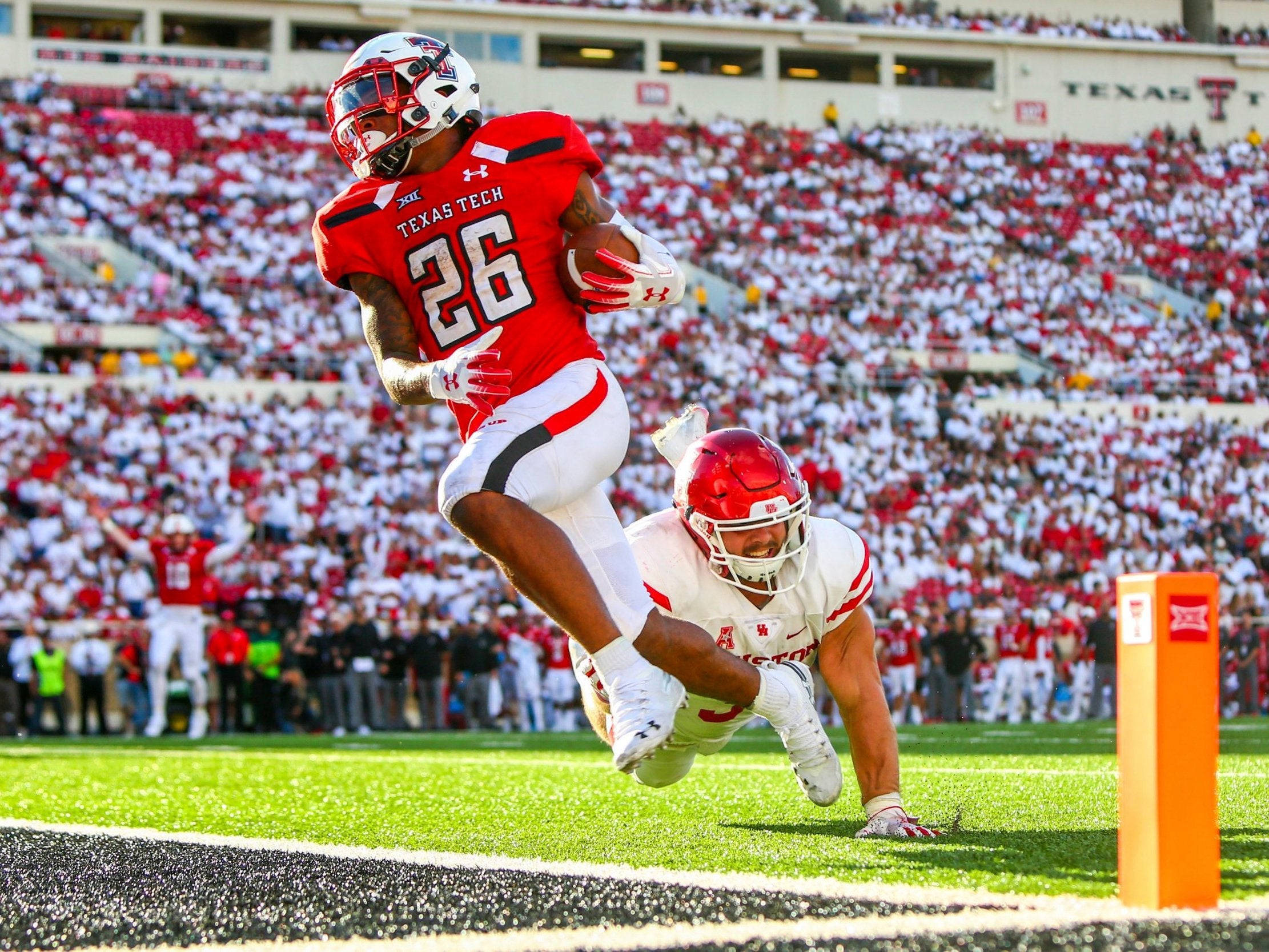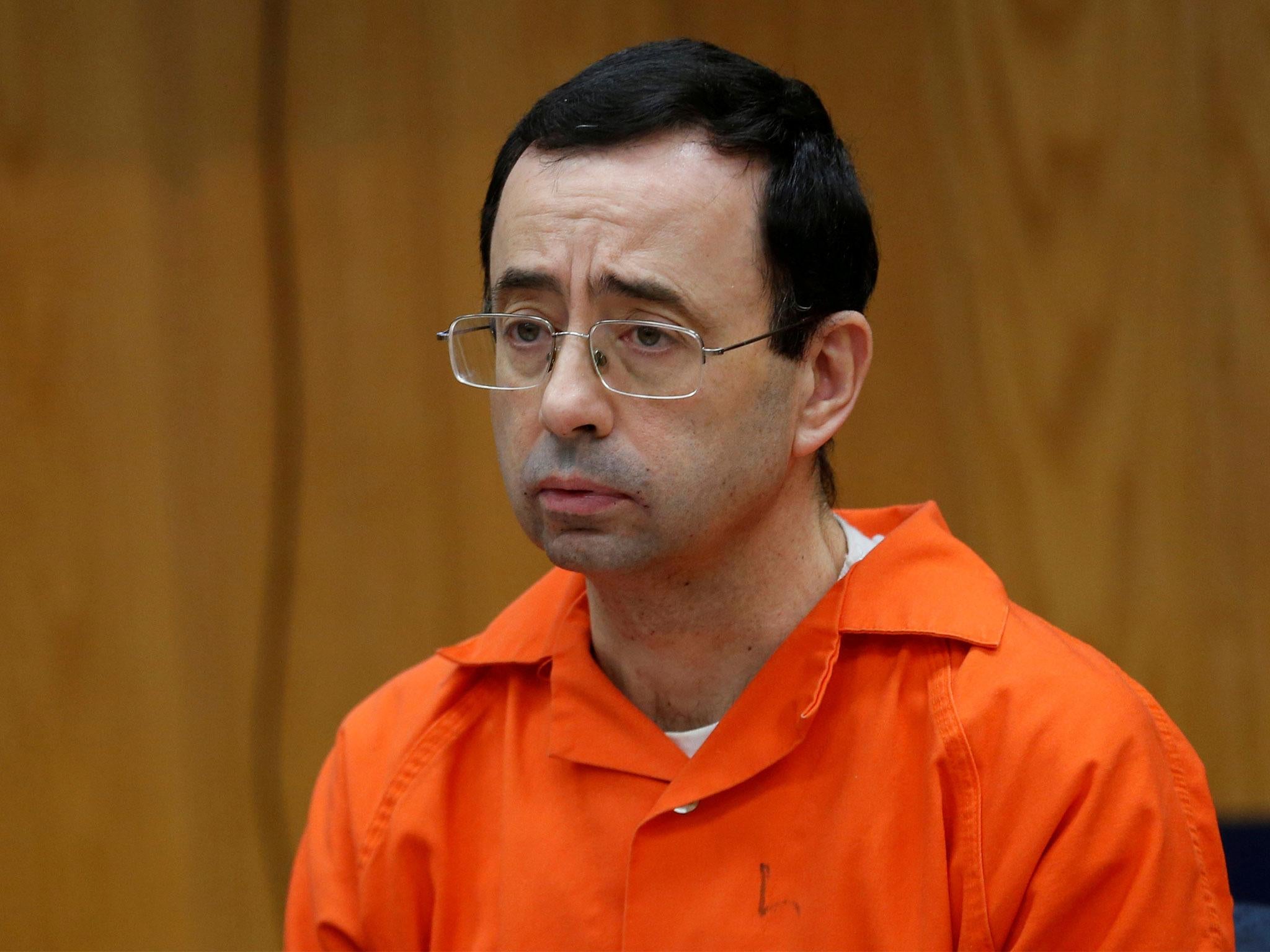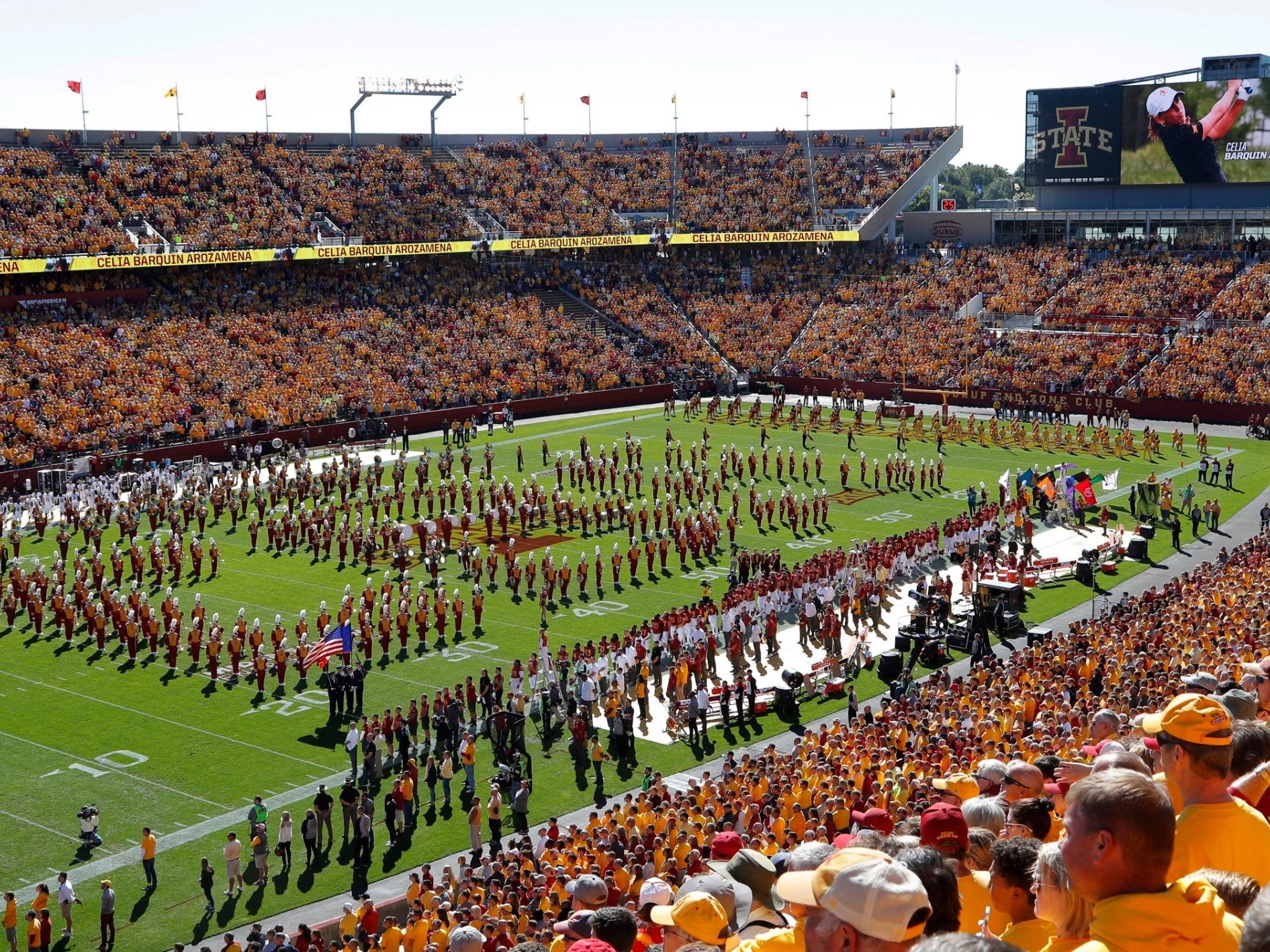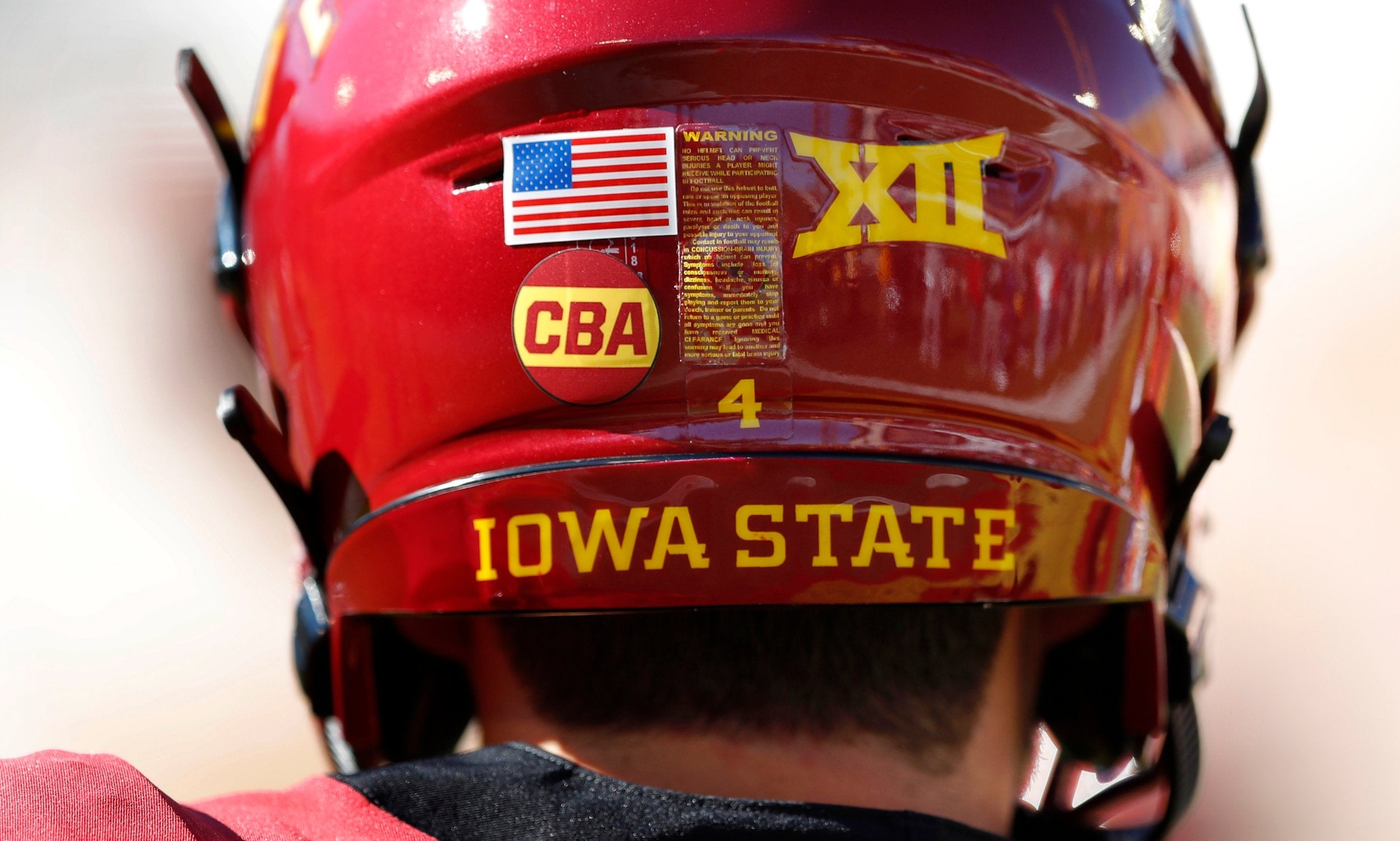The myth of amateurism: How America’s multi-billion-dollar college sports industry exploits its stars
The US is the only place in the world with such a booming industry in higher education, and it is protected by a cloak of secrecy, writes sports historian Victoria Jackson

Greetings, real football fans. You’re in the midst of an international break, and I’m an opportunist, looking to capitalise. So, please set aside your affinity for the superior form of football and take this time to join me, an American, for an overview of what’s happening in American college football – and college sports in general – this fall.
On the West Coast, in a California federal court room, amateurism in college sports is on trial again. The NCAA (National Collegiate Athletic Association) is fighting another antitrust lawsuit, this one claiming the membership association places an artificial cap on athlete compensation. The NCAA’s defence? That paying athletes will hurt their education and undermine their ability to earn quality degrees.
And on the East Coast, NCAA schools are in another federal courtroom, the notorious Southern District of New York, thanks to an FBI probe into the underground labour relations of college basketball – an economy driven underground by the NCAA and schools’ rules of amateurism. The schools claim they are victims of actions taken by former Adidas employees and agents, who allegedly paid star recruits money to attend the shoe and apparel company’s sponsored schools.
At the University of Maryland, footballers are playing games and attending class – an attempt at business as usual – while trying to make sense of how their teammate Jordan McNair died during practice earlier this summer. His death was potentially preventable, and it pulled back the curtain on a troubling culture of toxic masculinity.
At Ohio State University, Urban Meyer sat out the first three games of the season because he may or may not have admitted to knowing and not doing enough to report that his assistant coach Zach Smith had allegedly been abusing his ex-wife Courtney Smith. Meanwhile, former Ohio State wrestlers filed a pair of lawsuits seeking class-action status, alleging Dr Richard Strauss, a team doctor, abused as many as “1500 to 2500 male student athletes” during his tenure.
In East Lansing, Michigan courthouse, only months earlier, Dr Larry Nassar, the former team doctor for Team USA Gymnastics and also Michigan State University, was sentenced to 40 to 175 years for sexually abusing hundreds of girls and women over nearly 20 years of holding an esteemed position in the world of elite gymnastics.

And finally, at Tennessee State University, a student named Christion Abercrombie is in a critical condition after incurring a traumatic brain injury in a football game against Vanderbilt University on 29 September. He has undergone brain surgery and is fighting for his life, yet his school asked for the removal of all but one GoFundMe account to help his family pay for his medical expenses, citing concerns over the young man’s ability to retain his amateur eligibility. Over the weekend, the NCAA shut down an attempt by the Universities of North and South Carolina to hold a charity basketball game for Hurricane Florence relief; again, in the interests of protecting amateur sport.
If you started this column thinking I’d be bringing you up to date on the college football power rankings or previewing the college basketball season that’s about to commence…well, I guess now you realise you were mistaken.
Each of these stories is a product of the artificial concept of collegiate amateurism – even the tragic ones of injury, death, and abuse. Amateurism is the foundational ideology – the myth – that makes college athletic departments – like those at Maryland, Ohio State, and Michigan State – ripe for potential scandal. It serves as a protective cloak of secrecy under the pretence of morality and purity. And it also conveniently allows schools to share only a small fraction of all the money they make off football and basketball players’ backs with those athletes.
For Americans, it takes serious cognitive dissonance or blind ignorance to be a college sports fan in 2018. For those residing outside the United States and perhaps not as enraptured by the seemingly daily crises and scandals of college sports, I can only apologise if I’m ruining college football or basketball for you. If you’re not a regular consumer of our college sports games, you’re likely surprised and horrified.
I travel outside the United States as much as I can, and when I do, like most people, I’m asked about my work. I like being asked because I have a cool job (and also the confidence of an athlete). I’m a sports historian at Arizona State University. I’m also a former NCAA champion and retired professional runner. While I teach all sorts of sports history courses, my research focus is American intercollegiate athletics. A decade ago, outside the US, that would be an awkward conversation stopper. But over the years I’ve improved at making a convincing case about the interesting peculiarity of our college sports system, even to a foreign audience without much knowledge beyond March Madness or the Bowl Championship Series.
While most historians of the United States resist virtually any argument claiming American exceptionalism, this is one case in which we must emphasise the unique nature of the big business – and accompanying scandals – which Americans allow to thrive on our college campuses. The historical cornerstone is this: when the rest of the world professionalised and commercialised sport as the Olympic Movement abandoned amateurism in the 1980s, the United States pursued a broadly similar path, but with one significant difference. Like you, we professionalised and commercialised sport, but, unlike you, we kept it amateur for some of the athletes, calling it “educational” because it existed in our schools.

In truth, college sports had already been amateur (for the athletes), and commercial and professional (for everyone else) since at least the 1920s. In 1929 the Carnegie Foundation commissioned a major study into the troubling aspects of big-time college football. After more than three years of research, Dr Howard Savage and his team published “Bulletin 23: American College Athletics,” a 311-page report seeking to expose and eliminate college football’s vices: a “win-at-any-cost” culture that distorted educational priorities for all students on campus; placed too much emphasis on recruiting; paid coaches too much money; encouraged academic laxity; and fuelled the underground subsidisation of athletes.
If you think the Carnegie Report served as a call to action, you would be mistaken. While higher education leaders, most notably the University of North Carolina’s Frank Porter Graham, made attempts at reform and a “return to sanity” during the 1930s and 1940s, these efforts represented a momentary pause in college sports’ hundred-year history of professional and commercial growth. The post-war economic boom of the 1950s – plus easier air travel, the explosion of television sets in American homes, and a thriving consumer culture – formed the foundation of college football’s market growth and mass popularity.
The highest paid public employee in 39 of the 50 states is a college coach
It would take a dictatorial, authoritarian leader, however, to take these conditions and shape the NCAA into the multi-billion-dollar industry we know today. Executive Director Walter Byers – the association’s first and only executive director – took the reins in 1951 and presided for more than 35 years over the growth of the NCAA bureaucracy, overseeing major changes to the structure of the organisation to professionalise and commercialise college sports. Byers’s first major victory as Executive Director was his negotiation of association-wide television contracts, raising the national profile of college sports and making possible the NCAA’s and schools’ future economic growth.
As the money – and therefore, athletes’ time commitments – in football continued to increase, state industrial labour relations boards began to treat athletes as employees, awarding workers’ compensation benefits to injured athletes and, in California, the widow of a deceased athlete, Cal Poly footballer Gary Van Horn. Recognising the existential threat, Byers and his legal team continued to add language to the association’s rulebook, the NCAA Manual, emphasising the amateur and educational nature of sports for the athletes. They scrubbed it clean of any terminology suggesting athletes were employees, having already coined the term “student-athlete” to emphasise the educational purpose of sport.

What had been at stake was much more than death and injury benefits, but the entire college sports system as they had constructed it. If athletes were deemed employees, they could enter the free market just like coaches, athletic directors, maintenance workers, and others, and demand more pay. The colleges and the NCAA might lose their educational tax-exempt status, and the whole system would have to fundamentally change.
By latching this new, professionalised, commercialised structure onto idealised notions of amateurism, even when the content of the structure was the definitional opposite of amateur sport, the NCAA and member institutions could keep college sports as they were, no matter the embedded contradictions or even hypocrisy. In 1973, the NCAA replaced four-year scholarships with one-year-renewable grants-in-aid; the cloak of amateurism powerful enough to provide cover for an arrangement strongly resembling an employment contract.
But in the historically critical decade of the 1980s, when the world largely abandoned athlete amateurism, the US Supreme Court busted the NCAA TV monopoly, allowing conferences and schools to compete in an open market, thus creating a dramatic explosion – and recession-proof increase – in the money in college sports ever since. And so, we can make this bizarre and bold statement of American exceptionalism, unabashedly and without qualification:
44
Head coaches making at least $3m a year from their schools
The United States is the only place in the world with a multi-billion-dollar sports industry operating in higher education, with underpaid labour provided by “amateur” student-athletes.
I say this regularly. And I’m still blown away every time I make the statement.
We should find it strange that our higher education sports teams are one of the biggest American sports industries, with schools reaping the benefits. Fifty-eight school athletics programmes reported revenues above $50m in 2016-17, with 31 above the $100m mark. The University of Texas Longhorns topped the list at $214,830,647.
We should also find it strange that the highest paid public employee in 39 of the 50 states is a college football or basketball coach. This 2018 football season, 60 head coaches are making at least $2m in salaries from their schools, and 44 are making at least $3m. University of Alabama coach Nick Saban tops the list, again, raking in $8,307,000 this year.
Should schools even be in the sports business?
Also strange: Despite all this money exchanging hands, and all the people employed in the expansive college sports industry, the NCAA and member institutions state that participation in college sports is educational, that a college scholarship is priceless for athletes. Remember, lawyers are currently arguing in federal court that if athletes were to make any money (beyond their scholarships), the income would harm their ability to earn a quality education. Never mind all other student workers who do less glamorous jobs without any consideration of how that might harm their learning. Paternalism much?
What’s more, why isn’t the NCAA as concerned about the effects of money on coaches’ lust for winning (and more money)? Shouldn’t the NCAA also be arguing that coaches should make less money because multi-million-dollar salaries make them prioritise winning over education? A coach who makes a salary equivalent to, say, a full, tenured professor, might just care more about the education, health, and wellbeing of his athletes than winning at all costs.
Many Americans believe the NCAA PR machine, and think the scholarship deal benefits the athletes more than the schools. They repeat the NCAA messaging that “most athletes go pro in something other than sports” and see those who complain as whiny and entitled: scholarship athletes get a free world-class education, and get to travel and play the sports they love thanks to their schools and the NCAA.

For athletes like me in the non-revenue sports like track and field, golf, and tennis, I would agree absolutely: this system works in the vast majority of cases. We’re the beneficiaries of collegiate amateurism. We played our sports, earned those world-class degrees – and for those of us on full scholarship – did it all for free.
In my case, I got to “go pro” in both sport and career – I signed a Nike contract and competed on the pro track circuit for a bit, and now I’m living the dream: I earned my PhD and now get to be ASU’s sports historian. All thanks to the foundation laid by that college scholarship.
But it’s a bifurcated – and, yes, exploitative – system. The money brought in by the labour of football and basketball players is what allows the rest of us to thrive. Precisely because schools do not pay them what they’re worth. And too often the athletes raking in the dough are not enjoying the same educational experiences as athletes like me in the non-revenue sports.
In recent years, academic scandals, like the greatest case of academic fraud in NCAA history at the University of North Carolina – my alma mater, and something that occurred unbeknownst to me at the time – have inspired a growing body of NCAA critics. They question the value of collegiate amateurism –the scholarship model – for athletes in the revenue-generating sports, primarily men’s basketball and football. They note that too often the quality of their educational experiences are not on par with the regular student body, their sports require them to work upwards of 40, even 50 or 60, hours per week, and competition travel commitments force them regularly to miss class. This compromised education, coupled with the economics I’ve outlined above, has inspired critics to pose a question that has become a popular debate in major publications, think tanks, polling efforts, and most sports bars throughout the US: Should college athletes be paid?
Higher education is in the business of critical thinking, and we allow this one space – the athletic department – to eschew it
After a decade of study and reflection, I think we’re asking the wrong question. Not because college athletes should not be paid – they are paid, just underpaid – but because asking that question just won’t get us anywhere. The NCAA juggernaut is simply too powerful. Remember, I’m a historian. The odds are forever against a legal team representing athletes and arguing before judges and justices who believe the NCAA and schools’ PR machine. We can keep our fingers crossed, but in the meantime, let me pose a different, more radical set of questions:
Are schools failing in their educational mission to develop brains and bodies? In other words, should schools even be in the sports business? And, more tragically, why have we been allowing them to get away with horrible business practices?
Considering Christion Abercrombie and Jordan McNair, do schools value football players’ lives?
Considering the FBI probe into college basketball, do schools, the NCAA – even the federal government – care more about policing amateurism than they do about ensuring athletes receive the world-class educational experiences they’ve been promised?

Considering the stories of decades of abuse emerging from multiple campuses, do schools care more about the negative PR of a publicly-exposed scandal than the well-being of the athletes they’re supposedly serving?
College athletic departments are ripe for scandal because of the win-at-all-costs culture of big-time college sports. And their university hosts have permitted sports to operate independently and separately from the academic core of campus.
Higher education is in the business of critical thinking, and we allow this one space – the athletic department – to eschew it. This should be unacceptable to everyone who works in or cares about higher education: administrative leadership, faculty, trustees, proud alumni; not to mention the general public. Faculty like me should be regularly reaching out to athletics administrators and coaches to serve as a constant reminder that we are all educators. That this is a college campus, no matter how fancy the shiny new sports facilities or how important the “big game” on Saturday.
What about you, person who is missing real football and reading my diatribe against the current state of American college sports? You can help put pressure on these institutions. And you can help me in my mission to replace American football – which many of us believe is inherently harmful to brains and bodies – with the superior football you know so well in Europe. The United States, along with Mexico and Canada, is hosting the 2026 men’s World Cup, so we have a convenient deadline. Our goal should be to replace American football with the world’s beautiful game within the next eight years. While we’re at it, let’s make the sport around which American college towns organise their fall community rituals both men’s and women’s football.
Victoria Jackson is a sports historian and lecturer of history in the School of Historical, Philosophical, and Religious Studies at Arizona State University. She is a former NCAA champion runner and retired professional track and field athlete.
Join our commenting forum
Join thought-provoking conversations, follow other Independent readers and see their replies
Comments